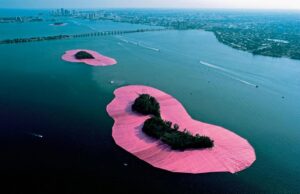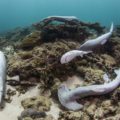
As a sustainability major over the past four years I have learned about the effects of waste and how harmful it is to the environment. Everything generates waste and has an impact on the environment, human health, and the economy. The question is, is self-expression worth the waste it creates? For how long? Should artists be more sustainable at the expense of their creativity?
In short, yes. For example there are many hazardous materials used in art. Aerosol product “SEM 39143 Trim Black” contains 14 toxic substances, four of which cause cancer, and five of which are identified as harmful by the EPA (Environmental Protection Agency). The environment’s safety is just one of the many sacrifices artists face when creating art…is it a necessary evil? Again, from a sustainability stand point this is avoidable. It is not ethical to alter the environment for artistic ends ever.
Land art, earth art, or earth works is a style of art that involves using the natural environment as a canvas for expression. Generally this art is used to show the relationship between man and the environment which can spark important conversations about conservation of our earth. Despite this, earth art can be harmful to the environment posing the question if it is really worth it to start a conversation about the climate at the expense of the climate itself.
This paradox is represented in the Bulgarian artist Christo Vladimirov Javacheff. Christo creates large-scale installations, many of which he has created in natural landscapes. Christo and his partner Jeanne-Claude were known for there expansive temporary works of art often made from industrial materials like steel, fabric, and plastic. Their projects often caused controversy with local authorities and landowners. Some of their works include the “Running Fence,” a 24.5 mile long fence built along the freeway in San Francisco. This piece of art took Christo and Jeanne-Claude many years to execute and only stood for about two weeks. Their other most famous piece is called, “Surrounded Islands” pictured here and constructed in Miami in the 80’s. The piece was meant to represent the relationship people have between land in water, especially in Miami. Eleven islands were surrounded by 603,870 square meters of floating pink fabric that could have been detrimental to the environment. There is no proof of where this fabric went after the piece was taken down. Polypropylene fabric is not biodegradable and artists are not always held responsible for the waste they generate. This project took years of effort getting permits, money, materials, etc. but at what cost? Was the representation of how people reside in south Florida worth it?
These examples may not be enough to stir up disdain for Christo and his work, and this article is not to say he is not talented and creative. This article is meant to draw the line in the sand and protect what we have left. Art waste is a significant issue facing the art world today. This waste can be generated during creation, display, and disposal of the art work. This issue is obviously multifaceted and involves environmental, economic, and social concern. Although Christo did not use toxic substances to my knowledge, most artist do, and his materials were not all biodegradable. This contributes to an already extremely prevalent culture of disposal. The value of objects is only measured by their immediate use or aesthetic appeal. Going forward art projects like these should promote sustainability and work towards goals of repurposing materials or recycling materials. Art waste is a problem that is too often swept under the rug while our planet suffers the consequences unable to speak up.


